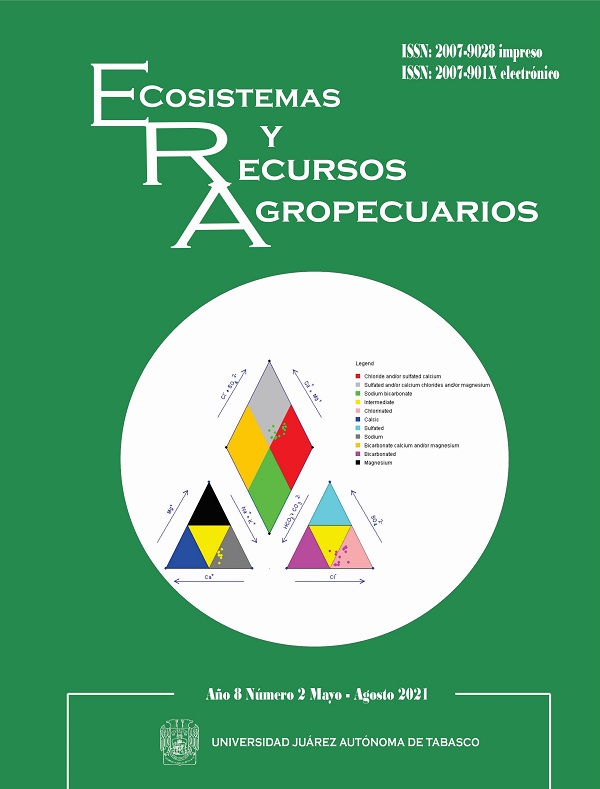Evaluation of the quality of irrigation water using the Agriwater software
DOI:
https://doi.org/10.19136/era.a8n2.2636Keywords:
Salinity, Sodicity, types water, Effective salinity, Potential salinityAbstract
Since water is an increasingly limited resource, having methods for evaluating its quality is necessary to ensure an adequate and sustainable
use for human consumption, agriculture and industry. The aim of this work was to describe agriwater software for evaluating the quality of irrigation water. The software consisted of the following stages: a) development of a database capable of hosting all the information stored in the software; b) conversion of chemical units; c) indexes calculation; and d) evaluation of performance and efficiency in data processing. The Agriwater software converts measuring units of ions to mg L-1, meq L-1 and mmol L-1, calculating the following water quality indexes: sodium absorption ratio, effective salinity, potential salinity and chloride toxicity. The result is Agriwater software, a professional tool that can handle, analyze and evaluate thousands of data in seconds in an intuitive and simple way.
Downloads
References
Ayers RS, Wescott DW (1985) Water quality for agriculture, FAO Irrigation and Drainage Paper. 1st ed. FAO. Rome, Italy. Falta el número total de páginas
Bautista F., Pacheco A., & Delgado-Carranza Ma. Carmen. (2015). Evaluación de la Calidad del Agua de riego Agriwater (1st ed.). México, D.F.: Skiu.
Bautista F., Pacheco A., and Bautista-Hernández D.A. (2016). Climate change analysis with monthly data Clic-MD (1st ed.). Software manual. México: Skiu.
Carlón, T., and Mendoza, M. (2007). Análisis hidrometeorológico de las estaciones de la cuenca del Lago de Cuitzeo. Investigaciones Geográficas, 63, 56-76.
Castañeda M. and M. González. (2008). Statistical analysis of the precipitation trends in the Patagonia region in southern South America. Atmósfera. 21, 303-317
Delgado, C., Bautista, F., Ihl, T., Palma-López, D. 2017. Evaluación de la aptitud de tierras para la agricultura de temporal usando la duración del periodo de lluvia en el estado de Yucatán. Ecosistemas y Recursos Agropecuarios, 4(12):485-497.
Delgado, C., Pacheco, J., Cabrera, A., Batllori, E., Orellana, R., and Bautista, F. (2010). Quality of groundwater for irrigation in tropical karst environment: The case of Yucatan, Mexico. Agricultural Water Management, 97, 1423–1433.
Ebrahimia M., Kazemia H., Ehtashemib M., and Rockawaya T.D. (2016). Assessment of groundwater quantity and quality and saltwaterintrusion in the Damghan basin, Iran. Chemie Erde – Geochemistry, 30(Issue 2), 227-241
Gungor A., and Arslan H. (2016). Drainage Water Quality Assessment Using the Irrigation Water Quality Index in Çarşamba Plain in Turkey. Journal of Agricultural Faculty of Uludag University, 30, Number: Special Issue, 357-363
González-Acevedo Z.I., Padilla-Reyes D.A., and Ramos-Leal J.A. (2016). “Quality assessment of irrigation water related to soil salinization in Tierra Nueva, San Luis Potosí, Mexico”, Revista mexicana de ciencias geológicas, 33(3), 271-285
Gibbons, R.D., and Coleman D.E. (2001). Statistical Methods for Detection and Quantification of Environmental (1st ed.), Wiley, New York: JONH WILEY & SONS, INC (Detecting Trend)
Hounslow, A.W. (1995). Water Quality Data. Lewis Publishers., U.S.A.
Kendall, M. G. (1975) Rank Correlation Methods (4th ed.), London: Charles Griffin.
Mann, H. B. (1945) Non-parametric test against trend, Econometrica, 13(3), 245-259
Montiel-González C., Gallegos-Tavera A., Ortega A., Bautista F., Gopar-Merino F., Velázquez A., 2019. Análisis climático para la agricultura de temporal en Michoacán, México Ecosistemas y Recursos Agropecuarios, 6(17):307-316.
Nyamao N.R., Ouko O.E., Onyango F., and Otieno S. (2015). Statistical Trend Analysis of Residential Water Demand in Kisumu City, Kenya. American Journal of Theoretical and Applied Statistics, 4(3), 112-117.
Ortega A., Montiel-González C., Gallegos A*, Pacheco A., Bautista F. 2019. Climatic hazard indicators for rainfed maize in a developing country: the case of Bajo Balsas, Mexico. Nova Scientia, 11:26-52.
Piper, A.M. (1944). A graphical procedure in the geochemical interpretation of water analysis. Transactions American Geophysical Union, 25, 914-928
Palacios, V.O., and Aceves, N.E. (1970). Instructivos para el muestreo, registro de datos e interpretación de la calidad del agua para riego agrícola. Colegio de Postgraduados, Chapingo, México.
Pacheco A.J., Cabrera S. A., and Pérez C.R. (2004). Diagnóstico de la calidad del agua subterránea en los sistemas municipales de abastecimiento en el Estado de Yucatán, México. Ingeniería, 8(2), 165-179
Richards, L.A. (1954). Diagnosis and improvement of saline and alkali soils. USDA Agricultural Handbook 60, 160.
Silva J.T., Moncayo R., Ochoa S., Estrada F., Cruz-Cárdenas G., Escalera C., Villalpando F., and Nava J. (2013). Calidad química del agua subterránea y superficial en la cuenca del río Duero, Michoacán. Tecnología y Ciencias del Agua, 4,127-146.
WH. Waterloo Hydrogeologic. 2020. AquaChem 9.0 Water Quality Analysis Software. Canada, 379.
Downloads
Published
Issue
Section
License
Copyright (c) 2021 Ecosistemas y Recursos Agropecuarios

This work is licensed under a Creative Commons Attribution-NonCommercial-ShareAlike 4.0 International License.
Aviso de copyright
Los autores que se envían a esta revista aceptan los siguientes términos:
una. Los autores conservan los derechos de autor y garantizan a la revista el derecho a ser la primera publicación del trabajo con una licencia de atribución de Creative Commons que permite a otros compartir el trabajo con un reconocimiento de la autoría del trabajo y la publicación inicial en esta revista.
B. Los autores pueden establecer acuerdos complementarios separados para la distribución no exclusiva de la versión del trabajo publicado en la revista (por ejemplo, en un repositorio institucional o publicarlo en un libro), con un reconocimiento de su publicación inicial en esta revista.
C. Se permite y se anima a los autores a difundir su trabajo electrónicamente (por ejemplo, en repositorios institucionales o en su propio sitio web) antes y durante el proceso de envío, ya que puede conducir a intercambios productivos, así como a una cita más temprana y más extensa del trabajo publicado. (Consulte El efecto del acceso abierto).


